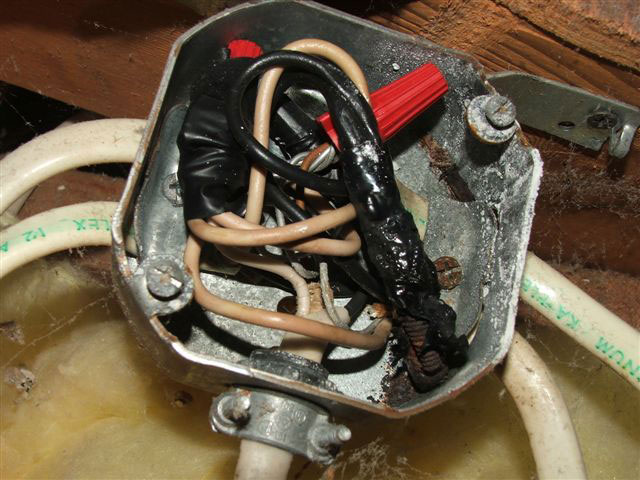Electrical Saftey and Wiring Hazards in your home
Introduction to Wiring Hazards
Did you know that outdated and improper wiring is a common cause of electrical fires in homes today? During a typical year in the United States home electrical problems account for 67,800 fires, 485 deaths, and $868,000,000 in property losses. Home electrical wiring causes twice as many fires as faulty electrical appliances. Most electrical fires result in problems with 'fixed wiring' such as faulty electrical outlets and outdated wiring that has been installed in older homes. In urban areas, faulty wiring accounts for 33% of residential electrical fires.
It is important to be educated on the dangers of improper, outdated and unsafe wiring. Doing so will help your home and family avoid becoming a statistic like the ones listed above. There are four main types of hazardous wiring that all homeowners should be aware of:
If you have any of these hazards in your home contact Seifert Electric, Inc. to come and evaluate the problems.
Knob and Tube Wiring
"Knob and tube is very old wiring, at least 65 years old, and in many cases has deteriorated, cracked, or is missing insulation, which can lead to fires." (The International Association of Certified Home Inspectors) Below are nine important facts to know about knob and tube wiring. Being aware of the dangers of this type of wiring is the first step in making your home a safer place to live.
KNOB AND TUBE WIRING FACTS
- Knob and Tube Wiring does not meet today's electrical codes.
- It uses free air to dissipate heat, so any contact with home insulation poses a threat of fire. (This is why many knob and tube homes were initially not insulated.)
- Unable to carry electric load needed for many modern appliances.
- Often improperly altered creating dangerous connections or a system pushed beyond its limits.
- Vulnerable to damage. When knocked or bent, wires can become dislodged or lose their insulation.
- Insulation can become brittle with age, leaving bare wire exposed.
- Can be damaged by rodents without homeowner's knowledge.
- Not properly grounded.
- May cause problems with homeowner's insurance.

Cloth Cable Wiring
Cloth cable wiring is a common type of electrical wire consisting of at least two insulated conductors and is used in residential wiring. Today, other types of cable wiring are always treated to make it flame-resistant and moisture-repellent. If you have an older home, there may be an older version of this cable present, which is much more dangerous than the new types of cable wiring that are being used in homes today. The dangers of this type of wiring are listed below.
CLOTH CABLE WIRING FACTS:
- Older versions of this cable were sheathed in cloth or asbestos. Asbestos sheathed cable poses a serious health risk and is directly linked to cancer.
- Cloth sheathed cable may not contain heat properly, and may pose a threat by exposing surrounding areas to excessive heat.
- Cloth sheathed cable can become brittle over time and crack. This would expose the bare wire and become a huge fire risk in your home.
- Both asbestos sheathed cable and cloth sheathed cable are seldom properly grounded.

Aluminum Wiring
The problems that are associated with aluminum wiring are now well understood. Having aluminum wiring in your home, over time, creates an increased chance of of a high resistance connection or arcing somewhere within your home's electrical system. A knowledgeable electrician that has experience with working with aluminum wiring will be able to examine your home and check for potential safety issues if your home has aluminum wiring. Some things that you need to know about the dangers of aluminum wiring:
Aluminum Wiring Facts:
- No longer permitted for new installations by most jurisdictions.
- Very susceptible to problems if improperly installed.
- Aluminum expands and contracts as it heats and cools.
- Excessive heat build up can melt the insulation.
- Wiring can oxidize and boost resistance causing it to heat up even more.
- Some anti-oxidant compounds uses on wiring in the past have been found to be flammable.
- May not be properly grounded.
- Poses a threat of arcing, causing a potentially high risk of shock.

Ungrounded Wiring
The ground wire of an electrical receptacle is important so that if any metal part of an appliance, tool, lamp, or the like becomes energized, the circuit breaker will trip and keep you from being electrocuted or shocked should you touch it. Often times, in older homes original wiring does not have ground wire connected to the outlets.
Ungrounded outlets are distinguished by their two slot configuration verses the newer grounded type of outlet that has three slots. A surge protector plugged into an ungrounded outlet will not operate as the manufacturer intended. Here are some other important things that every homeowner should know about the dangers of ungrounded wiring:Ungrounded Wiring Facts:
- If a tool or appliance is plugged into an electrical system that is not grounded, electric shock can occur which can cause burns or even death.
- Ungrounded systems can spark when something is plugged in and potentially cause a fire.
- Ungrounded electrical systems use up a great deal of electricity since the electrical current is constantly traveling throughout the system, causing higher electrical bills.

